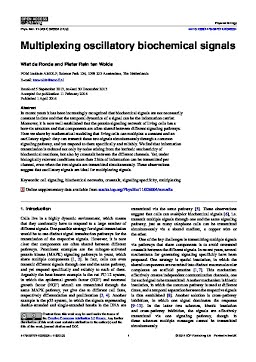2014-04-01
Multiplexing oscillatory biochemical signals
Publication
Publication
Phys. Biol. , Volume 11 - Issue 2, Article number: 26004 p. 1- 11
In recent years it has been increasingly recognized that biochemical signals are not necessarily constant in time and that the temporal dynamics of a signal can be the information carrier. Moreover, it is now well established that the protein signaling network of living cells has a bow-tie structure and that components are often shared between different signaling pathways. Here we show by mathematical modeling that living cells can multiplex a constant and an oscillatory signal: they can transmit these two signals simultaneously through a common signaling pathway, and yet respond to them specifically and reliably. We find that information transmission is reduced not only by noise arising from the intrinsic stochasticity of biochemical reactions, but also by crosstalk between the different channels. Yet, under biologically relevant conditions more than 2 bits of information can be transmitted per channel, even when the two signals are transmitted simultaneously. These observations suggest that oscillatory signals are ideal for multiplexing signals.
| Additional Metadata | |
|---|---|
| IOP Publishing Ltd. | |
| J. Alvarado (José) | |
| doi.org/10.1088/1478-3975/11/2/026004 | |
| Phys. Biol. | |
| Organisation | Biochemical Networks |
|
de Ronde, W. H., & ten Wolde, P. R. (2014). Multiplexing oscillatory biochemical signals. Phys. Biol., 11(2, Article number: 26004), 1–11. doi:10.1088/1478-3975/11/2/026004 |
|
